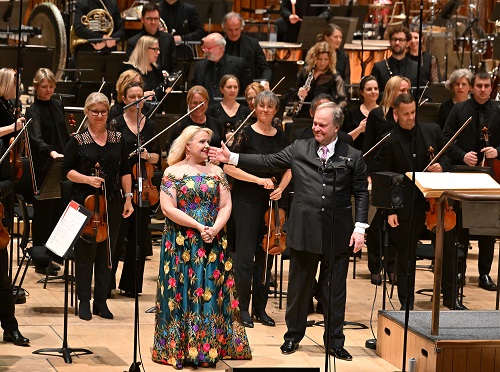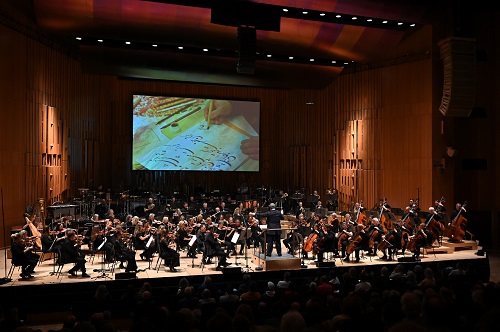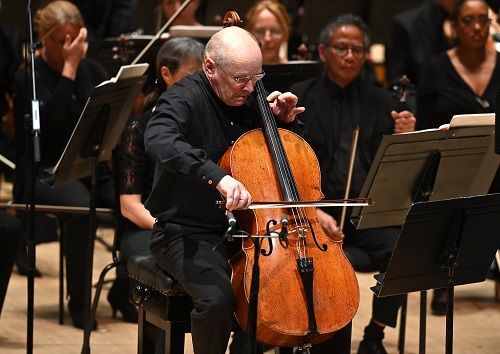‘Total Immersion’ is a good way of describing the music of the Finnish composer, Kaija Saariaho. The spectral sonorities that she creates by synthesising, manipulating and layering timbres, harmonies and rhythms form vast, dynamic sonic landscapes that shift and shimmer, and seem literally to embrace the listener, drawing them into a multi-sensory world.
Since the premiere of her first opera, L’amour de loin, in Salzburg in 2000, vocal music has had a central position in Saariaho’s oeuvre. Just last month her most recent opera, Innocence received its UK premiere at the Royal Opera House. But, even in the 1990s there were important vocal works: Château de l’âme (1995) for solo soprano, eight female voices and orchestra, Lohn (1996) for soprano and electronics (1996), and Oltra mar (1999) for mixed choir and orchestra. Saariaho has a particular fascination with the soprano voice which she has described as ‘my own voice, a woman’s voice’, and which she feels ‘bends in a completely different manner than male voices do’. And, she has been frequently inspired by specific voices – Dawn Upshaw, Karita Mattila, for example.
This Total Immersion day at the Barbican Centre comprised three concerts – chamber, vocal and orchestral – together with the UK premiere screening of The Echoes of the Universe: The Music of Kaija Saariaho (directed by Ritta Rask) and a talk led by the composer’s son Aleksi Barrière and Professor Jonathan Cross.
The BBC Symphony Orchestra’s evening concert included the UK premiere of Saarikoski Songs, settings of five meditative poems from Pentti Saarikoski’s collection, Alue (The District) which muse on nature and decay. The cycle was commissioned by the Finnish soprano Anu Komsi, a long-term collaborator with Saariaho. The first song ‘Luonnon kasvot’ (The face of Nature) was composed in 2013. Four years later, ‘Jokaisella on tämänsä’ (Everyone from now on will have their own) and ‘Kaikki tämä’ (All of this) followed, and the 15-minute cycle was completed during the pandemic lockdown of April 2020. The orchestral version of Saarikoski Songs was commissioned by the Boston Symphony Orchestra and the Gewandhausorchester and first heard in Boston in February 2022, with Komsi as soloist and conducted by Andris Nelsons.

Word and music, sound and noise, voice and instruments: the boundaries between them are blurred and crossed in Saariaho’s score which forms a sort of sonic continuum. Vocalise and text alternate in ‘Luonnon kasvot’, and Komsi’s crystalline soprano assumed a bird-like purity in the introductory vocalise, becoming more pressing and bravura – the urgency enhanced by the timpani’s militarism – with the image of a forest “obliterated by barbarians”. Later, though, there was pathos, a quietening, as the songs of extinct birds could be heard, repeating fragments of voice echoing elusively on the wind.
The care and precision with which Sakari Oramo coaxed the score’s sonic magic into being were equally impressive, and Komsi’s artistry was both stunning and absorbing. The fluctuations between registers, between types of sound, and the command of advanced vocal techniques both impressed and brilliantly communicated the ruminations of the text and music.
‘Jokaisella on tämänsä’ brought a fresh energy and expansion of colour, with vibrant woodwind and eddying textures, though there remained an ominous dramatic tone, deepened by the difficult angularity of the vocal lines. ‘Kaikki tämä’ was quiet, sombre, Komsi’s floating phrases almost ethereal, the anger of the preceding song stilled and assuaged. ‘Minussa lintu ja käärme’ (Bird and snake in me) began with an intensity that was almost aggressive, and, whipped up by the horns and percussion, Komsi’s soprano became heated and glowing. The final song, ‘Sumun läp’ (Through the mist), returns to the mood of the opening, and once again Komsi’s high vocalise soared with a compelling purity, though the instrumental harmonies injected a note of bitterness, and the calmness of the vocal line was belied by occasional busy, agitated interjections, before the final dissolution into an unearthly silence.

Text and music were again brought into communion in Circle Map (2012), in a synthesis of visual and aural imagery. The titles of Saariaho’s works often suggest a visual impulse, and she has explained that her ‘thinking is very visual’ and that her ‘sketches for many pieces are drawings’. Circle Map (2012) for large orchestra and electronics is based on six poems by the Persian poet, Rumi, which, read by Arshia Cont, are incorporated electronically into the 30-minute work. The title derives from a mathematical term referring to the interconnectedness of dynamic systems, the circle imagery also connecting to the poems through the Sufi belief that the suffering soul must make a journey to its source in order to understand the unity of the universe, and linking also to the Sufi whirling dervish dance. As the music unfolded, projected on a screen behind the BBCSO, a calligraphic pen preciously painted Rumi’s poems, the writing becoming circles and spiralling figures, ever more dynamic as the instrumental timbres – lot of brass and percussion, and propulsive ostinatos in the lower strings – deepened in colour and texture.
Oramo conjured a lot of kinetic force, leaning towards violence at times, as the BBCSO made manifest in new forms the sounds of the electronically manipulated spoken text. But, I confess that I found the density of imagery – the surfeit of diverse visual, verbal, aural, musical, electronic stimuli – too much to process, synthesise and understand. I let myself sink into the music’s mysteries and accept the work’s enigmas.
Notes on Light (2006-7) for cello and orchestra was much more compelling. Composed for Anssi Karttunen, the soloist here, the concerto reflects Saariaho’s fascination with light, each of the five moments envisioning the solo cello as a different source and aspect of light. Playing with a sinewy intensity and relishing the technical challenges – which sometimes reminded one of Saariaho’s experiments with electronic sounds and timbres – Karttunen brought all of Saariaho’s colours, refractions and luminous hazes into intense, tactile being, finding a strange beauty in even the most extreme registers, astringent sounds and anxious flutterings. Oramo and the cellist created a strong and cohesive narrative, as the relationship between soloist and orchestra developed in complex ways, the textures always transparent, the cello never ‘covered’.

The darkness of ‘Translucent, Secret’ was illuminated by harp gestures and glitterings which flared up in ‘On Fire’, and fizzled and bristled, alongside percussive flames and woodwind sparks. Oramo created momentary unity in ‘Awakening’, the orchestral unison swelling and fading in anticipation of Karttunen’s robust, gruff cadenza. This felt the heart of the work. In ‘Eclipse’, the cello was silenced by the orchestra’s cascading colours; in ‘Heart of Light’, the solo voice returned, aching and questing. The flutterings at the top of the cello’s register suggested a reaching, yearning quality, and as they drifted into nothingness, embodying the quotation from T.S. Eliot’s The Waste Land that is printed on the final page of the score: ‘I could not /Speak, and my eyes failed, I was neither/ Living nor dead, and I knew nothing,/ Looking into the heart of light, the silence.’
The concert opened with Du cristal (1989) for orchestra and electronics which brilliantly demonstrated the way in which Saariaho uses timbre and colour to create musical structures. Here, we had slowly unfurling vistas built from symmetry and repetition, alternations of forward motion and stasis, juxtapositions of tension and relaxation. As different instrumental groupings interpolated, the sound seemed to have a physical ‘weight’ that lifted and deepened by turn, like huge plates colliding, shifting, adjusting, creating a sense of the music being part of the natural world, or the celestial universe.
Oramo’s control of pace, changing metres and form was superlative, the etching of texture and colour forceful in its exquisite delicacy, rhythms incisive and sophisticated. In the long, long expanses there was something of Sibelius’s impressionism and his sense of vastness – the realisation of music as landscape – though Saariaho’s poetry of timbre was very much her own.
Claire Seymour
Anu Komsi (soprano), Anssi Karttunen (cello), BBC Symphony Orchestra, Sakari Oramo (conductor) Jean-Baptiste Barrière (film and electronics)
Kaija Saariaho – Du cristal, Notes on Light, Saarikoski Songs, Circle Map
Barbican Hall, London; Sunday 7th May 2023.
ABOVE: Anu Komsi with the BBC Symphony Orchestra, conducted by Sakari Oramo (c) Mark Allan